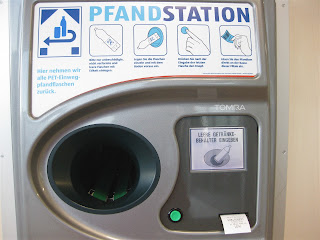All About Stuttgart 21
While in Stuttgart, we had the opportunity to participate in a guided tour of the plan for Stuttgart’s new main train station project - called Stuttgart 21. Germany is already really well-known for its insanely efficient, widespread, and connected public transport system (including busses, trains, subways, etc.), but this project is intended to continue to grow and improve this great transportation system that is already in place. This project is planned to be completed in 2021 (hence the name), and has many goals that are not only aimed at making life easier for residents in Stuttgart and the rest of Germany through transport, but also aimed at a cleaner environment and sustainability within the realms of transportation and mobility.
Currently, the train station is a “head train station,” meaning that it is the end of the rail line, so trains must stop in Stuttgart and cannot pass through. This project, Stuttgart 21, was implemented to rebuild the main train station into a “through station,” so that trains can pass through the city rather than stop and turn around, making travel paths less complicated in a city that is a big transportation hub for the country. The plan calls for four tracks and 57 new kilometers of rail line and has been quite expensive to implement, but these changes will allow for shortened travel times and more direct routes/connections throughout not just Germany, but also Europe.
(Image: http://www.bahnprojekt-stuttgart-ulm.de/projekt/ueberblick/s21-auf-einen-blick/)
The project has many proposed economic and community benefits, but I want to specifically focus on the estimated environmental and economical benefits of this project that contribute to Germany’s efforts towards sustainability. The main environmental benefit of this entire project is that more people will travel via train, rather than with their personal cars. It is estimated that millions of people will be shifted from traveling via the roads to the rail; this will significantly reduce CO2 emissions in the atmosphere - one of the hottest environment problems addressed by society today. A huge park will be created along with the rebuilding of the train station, in which more trees will be planted than will be cut down in the process. The rebuilding process also includes a plan to reduce noise pollution both during and after construction - the placement of springs under the tracks and other techniques will dampen the noises from the rail traffic. With the building of tunnels underground, a ground water and mineral springs management plan has been executed to keep water clean and plentiful.
Even though there is plenty of opposition to this project due to its cost and goal feasibility, it is evident that the sustainability and environmental effects behind the project have been well thought-out and planned with a long-term mindset. The goals of Stuttgart 21 strive towards a more sustainable transport and mobility system that is interconnected and structurally progressive, which is something that we are most definitely lacking in Atlanta. Being exposed to this massive project and learning about how it is aimed towards building upon sustainability in many facets has been eye-opening, and I hope that the project’s aims can be used to build a public mentality and attitude that supports such projects and concepts in the United States.
Click HERE to view the Stuttgart 21 webpage for more info!
(Image: http://www.bahnprojekt-stuttgart-ulm.de/projekt/stuttgart-filder-s21/neue-bahnhoefe/hauptbahnhof-stuttgart/)
Click HERE to view the Stuttgart 21 webpage for more info!



Comments
Post a Comment